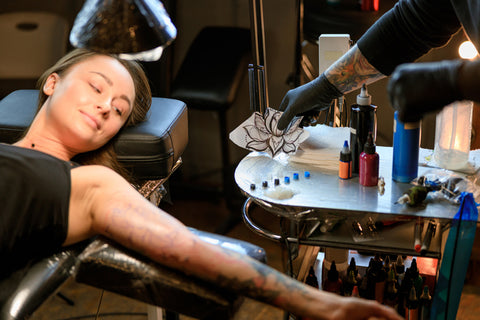Words by ANONYMOUS (Well known from Los Angeles, California who likes to remain offline as much as possible and let his work speak for itself – Industry people will know.)
Introduction
When I first started out, tattooing was more than just an art form to me; it was a medium to connect deeply with people. Every client came with a unique story, and I had the privilege to translate that into a lasting piece of art on their skin. And as tattoos became more accepted and cherished in many cultures, I knew I had chosen a path full of potential and personal rewards. Growing up in a rough East LA neighbourhood also helped shape my connection to the real and raw stories people translated through their body art and I really connected with that.
Education and Training
My love for art has been a constant throughout my life. I honed my skills through art classes in school, graffiti on the streets and later pursued a formal education in fine arts. The essence of tattooing lies in the details, so I made it a habit to practice my drawing, shading, and understanding of colours daily. My sketchbook became my closest companion, capturing my progress and ideas. It was the expression of my inner monologue and creative soul.

Apprenticeship
My first (legal) real hands-on experience began when I apprenticed under a veteran tattoo artist in East LA. Finding the right mentor was a journey of its own—I networked at local studios, attended conventions, and endlessly browsed online forums. Those 2 years of apprenticeship, which were a mix of learning, observing, fetching coffee, cleaning and sweeping the whole damn studio were all worth it. I was trusted enough to eventually tattoo clients under supervision, which was equally challenging and invaluable, but I knew I found my path in life.
Licensing and Certification
It’s vital to make sure you’re doing everything above board. I had to go through a specific number of training hours and then take a licensing exam. And, of course, the Blood-borne Pathogen and Infection Control training was a must. Always check with your local regulations to ensure you’re complying—it’s essential both for you and your clients.
Building a Portfolio
Building my portfolio was a journey of passion and creativity. It’s like a visual CV that showcases your range and versatility as an artist. I made sure to include a diverse set of designs, techniques, and styles. Taking before (the initial sketches) and after (the completed tattoo) photos provided a comprehensive view of my skills. A lot of my work stems from my upbringing and my environment, which is relatable to a lot of my repeat clients.
Getting a Job or Opening a Shop
After my apprenticeship, I faced a crossroad: Should I join an existing shop or start my own? Working in a shop gave me more experience and a steady flow of clients. But later on, when I felt ready, I branched out and opened my own place. Owning my own tattoo studio brought additional responsibilities like business permits and marketing, but it also gave me creative freedom. I am really happy doing what I love and as much as I like to stay out of the spotlight, I know i’m only able to do so because so many people love coming to see me for their work and that keeps it all churning.
Continuous Learning
The day you stop learning in this profession is the day you stagnate. Even today, I make it a point to visit other artists studios and conventions to learn about emerging styles, and share experiences with my peers. Tattoo art is evolving, and I want to evolve with it.
Conclusion
Becoming a tattoo artist is not just a job; it’s a commitment to art, to clients, and to continuous learning. It’s about passion, dedication, and the relentless pursuit of mastery. If you’re considering this path, know that it’s challenging but incredibly rewarding. Always remember: It’s not just ink on skin; it’s a story that lasts forever.